
The last French cruiser
With the start of the cold war France still possessed a number of cruisers and a modernized battleship (Jean Bart), which provided cover for its aircraft carriers. In 1946 was launched her last prewar unfinished cruiser, the De Grasse completely redesigned and reconverted as a modern AA cruiser with command facilities. Soon the design was jusged s successful the admiralty ordered in 1953 a sister-ship at Arsenal de Brest, to be named Colbert.
The new cruiser was eventually completed in 1959, three years after De Grasse, with a very similar arrangement and artillery. The two cruisers operated for years as fleet escorts until their path diverged with the advent of the missile era. De Grasse became a command ship for nuclear experiments in the pacific while Colbert was taken in hands in 1968-70 to be completely recbuilt as a missile cruiser, the only one in the French Navy. She served for the remainder of the cold war, a known ambassador of the French Navy around the world with the other cruiser of the fleet, the helicopter cruiser Jeanne d’Arc until the end of the cold war. She was later decommissioned and anchored in Bordeaux for her second life as a museum ship.
Origin and development of the Colbert
The Colbert was initially planned to second the cruiser De Grasse, as an oceanic aircraft carrier AA escort. She was basically a sister ship, built with a considerable gap, between 1938 (the keel of De Grasse being laid down) and 1950, when the new cruiser was planned. In between other solutions were studied, notably the conversion of former inerwar cruisers still extant at that time: The Suffren and Montcalm notably were in good general state, relatively recent still, and could be modernized. However as they were designed with larger turrets and with all their loading systems in barbettes also tailored for a traditional heavier gun, the conversion was judged too costly. It seems more interesting to just copy the De Grasse conversion plans and applied them to a brand new ship.
There were back-and-forth discussions before the design was ready in early 1952, with modifications directly driven by studying De Grasse’s plans and trying to improve the design in many points. The design was approved and construction was approved and planned in FY1953 budget. The final plans of Colbert retained the same specifications, with an almost identical silhouette and the exact same artillery plan, but the hull and machines underwent many revisions. Indeed the De Grasse hull was basically a 1938 design, with a standard poop and turbines based hig speed machinery, which impacted range. Superstructures followed the same general lines of the De Grasse, but been considerably redesigned, taking advantage of early feedback from De Grasse. Revisons were made during construction as well.
Colbert design: AA cruiser

The biggest change inside the hull was the powerplant (see later) but the hull lines were modified as well. Prewar designed stressed the best lenght/width ratio to take advantage of a powerful machinery. This was revised and the Colbert’s stern was modified for a transom stern, already used on the 1936 La Galissonière class and preferred now by the French as it presented hydrodynamic advantages. The hull’s final dimensions were als follows: An overall lenght of 180.5 m (592 ft 2 in), versus 188.3 m (617 ft 9 in) on De grasse, explained mostly by the transom stern, making the hull shorter. A beam pushed to 19.7 m (64 ft 8 in) at the waterline, versus 18.6 m (61 ft) for the De Grasse, but about 21.5 m at the upper deck level due to the hull flare. And a draft of 6.5 m (21 ft 4 in) fully loaded way more than for De Grasse 5.54 m (18 ft 2 in). Thes overall larger volume made for a slightly lighter tonnage however, 9,084 t (8,941 long tons) standard, 11,587 t (11,404 long tons) full loaded versus 9,389 t (9,241 long tons) standard, 12,350 t (12,155 long tons) full load. This was largely explained by the absence of armour and choice of a lighter and more modern powerplant.
The crew comprised, in 1959, 997 men: 70 officers, 19 senior masters and first masters, 52 masters, 108 second masters, 748 quarter masters and sailors.
Powerplant of Colbert
While the prewar De Grasse adopted two Rateau turbine groups from Chantiers de Bretagne rated at 52,500 hp, 39,149 kW each so about 150,000 shp, fed by four Indret oil-fired boilers, French engineers looks at a better way to dispense power on a lighter package while reaching a better range, a comon prewar critic of both Mediterranean-Oriented French and Italian cruisers. Indeed the Colbert was now classed as an oceanic escort, thus performing missions both in the Atlantic and Pacific. Range became crucial.
She received indeed 2 CEM-Parsons turbines groups, really the latest tech for steam turbines at the time, very efficient, and driving 2 propellers. They were fed by four Indret boilers, also of a modern design working at 45kg/cm², 450 C°. Total output was an honorable 86,000 shp or 63,286 kW. Top speed, as planned was reached and surpassed on sea trials: 33,7 knots, while it was limited to 32, and after the 1970s refit, down to 31,9 knots in 1987. Her range was however as good as planned, 4,000 nautical miles at 25 knots, so better than the 6,000 nm at 18 knots for the De Grasse. The powerplant was never changed and had a lot of commonality to the helicopter cruiser Jeanne d’Arc.
Armament
These two cruisers constitute at the same time the pinnacle and also the swan song for classic antiaircraft cruisers. At the start of World War II, AA artillery was seen as secondary still, directed only by optical devices, but already the US (wuth the Atlanta) and UK (with the Dido and many conversions) were looking into these ships as specialized escort. The war only confirmed these assumptions, etablishing air power to the eyes of many as the dominant force in WW2. Therefore, both the De Grasse and Colbert were bristling with heavy and intermediate cannons, but with just two caliber better suited to modern AA, long range and fast planes, including jets:
5-inches (127 mm)/54 Modele 1948:
For the ammunition commonality were saw already for the De Grasse and T47 destroyers, the 5 inches or 127 mm caliber was chosen because ot used the same standard US caliber, available in large quantities to NATO countries. Colbert, like De grasse, had sixteen in all: Four twin mount forward and four after, two at deck level in the ship’s axis, with a superfiring turret, and two in tandem on the superstructure deck. These guns were powerful and still dual-purpose, but they were over-complicated, required 11 trained personel per gun, with performances less than stellar with 11 rpm in the best conditions. Their ceiling was 29,530 feet (9,000 m). It was longer in antiship fire and gunnery support inland (up to 24,060 yards (22,000 m) at 45°).
57 mm/60 caliber 1951
These were basically the Swedish post-WW2 succesor of the legendary 40 mm Bofors. They were primarily intended for the short and medium range anti-aircraft protection.
The later completion of the Colbert as an AA cruiser was problematic. Indeed two years prior already, the USN was about to complete its first missile cruisers (converted). It will take another ten years before the Colbert accessed to a missile launching array, both to deal with AA and AS threats. In Italy, the Garibaldi, a converted Tartar missile cruiser in 1964, became the first missile cruiser in Europe, years ahead of the Colbert, although it used an already proven USN missile system. Italy also completed the two Doria soon after. So basically until 1972, the Colbert was obsolete. The 57 mm guns proved too slow for the 1960s jets generation, not speaking of the 127 mm. Her sister ship De Grasse was already converted as a specialized command ship, leaving her alone as task force escort, but De Gaulle’s policy to leave NATO meant France needed to develop its own SAM systems, instead of accessing already existing and proven US missile systems, long and costly to develop. These would take years in R&D, hence the late conversion.
Onboard aviation
Colbert had a lare enough transom stern to create an helipad aft. This helipad unfortunately due to structural reasons could not be followed by a hangar underneath. So whatever helicopter was carried for specific missions, it needed to be strapped and covered by a tarpaulin in between used. Facilities for maintenance were also limited. The ship for this reasons not always carried helicopters in missions, and it was for many years a single Alouette III by sud-aviation; This sturdy, dependable first-gen turbine helicopter had an excellent visibility for reconnaissance, SAR and liaison operations. In the 1990s it was replaced by an Aerospatiale Dauphin (now Airbus Helicopters).
Electronics
These guns needed to be controlled by stabilized radar telepointers, for roll and pitch, with automatic fire tracking. Repartition was the same as for the De Grasse: Two main telemeters were installed fore and aft on superstructures, while secondary systems were placed in the axis behind, in superfiring positions, and four systems on the bridge’s sides for the secondary AAA.
The large superstructures and lattice masts of the Colbert supported radar aerials and transmissions antenna.
Main radar equipments
The main air surveillance radar was the rectangular DRBV-22A (replaced by the end of 1959 par the DRBV 23) mounted on a lattice attached to the funnel, and the hemispheric DRBV-20A, placed on the platform of the main lattice mast after of the bridge. It was also replaced by the end of 1959 by a DRBV 20C. The ship was also given a DRBI-10B system and a DRBV-31 on the lower bridge platform a TACAN navigational system on the main lattice mast, and four DRBC-31B for the 127 mm guns, plus four DRBC-31A for the 57 mm AAA.
Transmission & electronic warfare
For transmission, the Colbert had 12 UHF antennae, 5 VHF radio systems, 3 HF systems, and a single MF systems, 18 portable transmitter-receptors, 7 transmitter and 28 receptors, as well as two gonios: One VHF et One MF for long range radio detection, and an AN/URD-4 system plus one Loran receptor and TUUM-1 underwater communication system.
Fo electronic warfare, Colbert was equipped with the following: One ARBA-10B and ARBR-10B signals distruption systems, a RRBM-1, later replaced by an RRBM-2 and an AN/SPR-1.
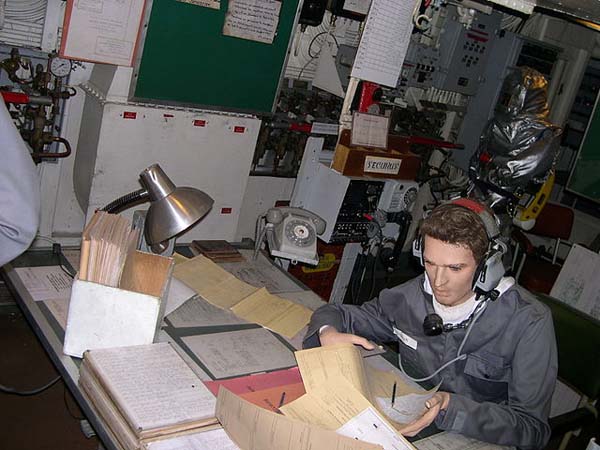
Command & Control Facilities
There was a consequent central information (CI) in the main bridge of the cruiser, which like De Grass, was meant to above all coordinate all assets in an area, and well beyond their practical range, for example to help coordinating long range air strikes from the carrier and landing operations. Their extensive communication suite allowed them to coordinate friendly fighter aviation, both in control, interception and relay, and play the role of a command ship for naval air operations in complement to aircraft carriers. But another aspect of the Colbert was its secondary role as rapid transport: It was capable of carrying in rapidly mounted accomodations, an intervention force of 2,400 men. This feature was never used during her career.
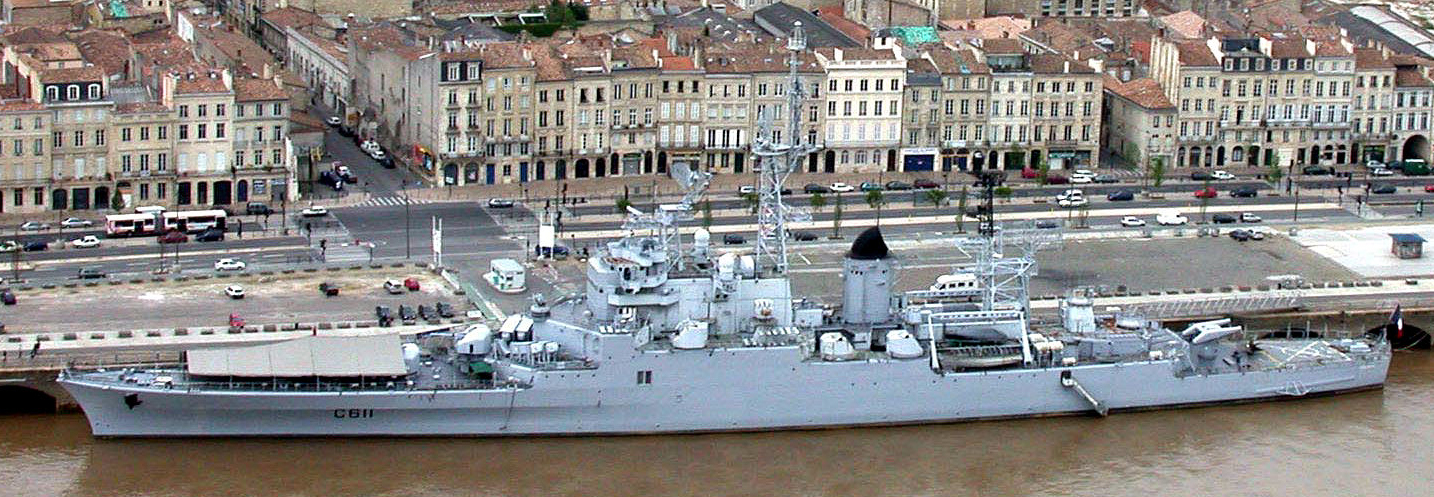
Colbert along the Quai des Chartrons, Bordeaux
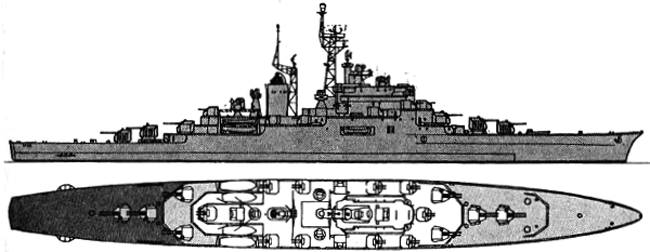
⚙ Colbert’s 1959 Specs |
|
| Dimensions | 9,085 t, 11,100 t FL |
| Displacement | 180.5/187m x 20.3m x 6.5 m |
| Propulsion | 2 CEM Parsons geared steam turbines, 4 boilers, |
| Performances | 877,000 hp, 33 knots, range 4,000 nm |
| Armament | Eight twin 127 mm M1958 DP, ten twin 57 mm M1951 AA guns |
| Sensors | Radar DRBV 20A, DRBI 10 |
| Crew | 977 |
Colbert’s early career (1968-1970)
Launched on March 24, 1956, Colbert begin her post-completion trials on December 5 1957 until officially admitted into active service on May 5, 1959, based in Toulon, Mediterranean Squadron. From 1959 to 1964, she alternated with De Grasse, as the flagship of the Mediterranean squadron and assumed this function alone from 1964 to 1995. Colbert’s representative role for France worldwide was also important. In 1961, she repatriated the ashes of Marshal Lyautey. In 1964, she escorted General de Gaulle on his tour of South America for three-week onboard his Sud Aviation Caravelle. De Gaulle was also hosted by Colbert from September 29 to October 1, 1964 and made athe crossing to Valparaís, a 900 mile journey along the Chilean coast. De Gaulle for the anecdote signed several laws and decrees later published as “Done aboard the Colbert. C. de Gaulle.” From October 10 to 13, she crossed to the Atlantic again and went to Montevideo in Uruguay and Rio in Brazil. The cruiser was soon known in “peaceful” missions of diplomatic representation, but was also implicated in humanitarian missions, using its internal facilities, bith to Agadir in 1960, and the evacuation to Bizerte in 1961.
In 1963 she was fitted with the new and expected DRBV-20C radar, greatly improving her long range detection capabilities. The radar was good enough to remain in service until the end of her operational career in 1991. Her most famous trip was in July 1967, carrying General de Gaulle in anoher American official visit, stopping at Saint-Pierre-et-Miquelon (July 20) and entering the St Lawrence river to stop in Montreal. During this visit he provoked controversy in Canada by declaring, to the delight of French Canadians “Vive le Québec libre!” in July 24 at Montreal City Hall. The following diplomatic incident cut short his official visit. Colbert still made yearly missions in the Mediterranean until 1970 and her decommission for overhaul.
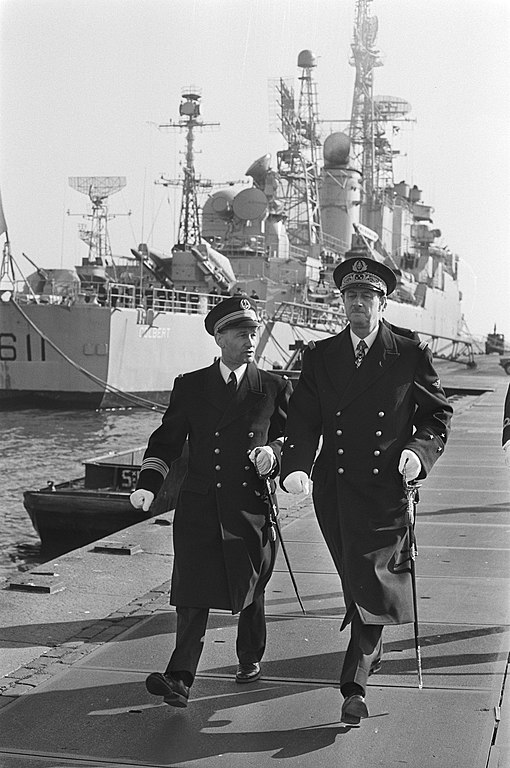
Vice admiral philippe De Gaulle during Colbert’s stop in Amsterdam, early 1970s, showing the cruiser’s aft Masurca SAM and guiding radars
✚ Read More/Src
On netmarine.net ⤤
On 33-bordeaux.com ⤤
On meretmarine.com ⤤
On navypedia.org ⤤
On Kronobase.org ⤤
About De Gaulle’s american trip on Colbert ⤤
The former museum site (archive) ⤤
On shipspotting ⤤
On boreally.org ⤤
French 127 mm naweaps ⤤
French 57 mm navweaps ⤤
Another gallery ⤤
Some footage ⤤
On wikipedia FR ⤤
Books:
Conway’s all the world’s fighting ships 1947-1995
“Le Croiseur Colbert”, Jean Moulin 01/01/1994 by Marines Editions (no longer available). ❑
René Besnault, « Chroniques. Visite des Amis de l’Institut à bord du croiseur Colbert », Espoir, no 107 ❑
“Colbert, le dernier croiseur” by Frédéric Bouquet ❑
Jean Meyer et Martine Acerra, Histoire de la marine française : des origines à nos jours, Rennes, éditions Ouest-France, 1994 ❑
Michel Vergé-Franceschi (dir.), Dictionnaire d’Histoire maritime, Paris, éditions Robert Laffont, coll. « Bouquins », 2002 ❑
Alain Boulaire, La Marine française : De la Royale de Richelieu aux missions d’aujourd’hui, éditions Palantines 2011 ❑
Rémi Monaque, Une histoire de la marine de guerre française, Paris 2016 ❑
The models corner:

Heller Colbert 1/400 – Src Scalemates
Also Heller Colbert 1/1200. Both before 1970s conversion. Note: I purchase the 1/400 heller Colbert a few years ago to show the kids what a model kit looked like back in the days and they helped me painting and assemble the model. It is the only one exposed at home, after all relocations. 20 years ago i used to have about 250 ship’s model kits, mostly scratch-built 1/700. All given up or just trashed.
Colbert’s reconstruction as a missile cruiser (1970-72)
Like De Grasse, or even the battleship Jean Bart, both started before the war but completed in the 1950s due to the disastrous state of the country’s finances and arsenals, Colbert entered service at the end of the 1950s. The rapid development of air threats and rise of the missile as a new standard defense system had the planned weaponry of the Colbert considered obsolete and ineffective. They were completely useless already in 1959 against supersonic combat aircraft, and in the later 1960s, the advent of efficient antiship sea-skimming missiles rendered Colbert even more vulnerable. She was completely supplanted by a new generation of ships more adapted to new threats. For example in France itself, in 1960 already, were studied two missile destroyers, the Suffren class. They were completed in 1967-70. More were to come: The Aconit and Tourville class.
To preserve the military value of the Colbert, more useful as a prestige ship at that point, the admiralty had the choice to either scrap her or overhaul her entirely, but withing the frame of drastic budgetary restrictions. Conversions plans as a missile cruisers started with studies in 1968, and led to a desfinitive design approved in 1970, with her conversion being voted. Conversion would take tow full years, from 1970 and 1972. She became in effect a missile cruiser and started a new life that would have her in service until the end of the cold war. Her new cornerstone, suitable for long range anti-aircraft warfare was her twin Masurca SAM missile launcher aft. This also imposed a decrease in classic AA armament and later in 1980, the addition of four MM-38 canisters forward enabled anti-ship capabilities. The electronic warfare, radar and fire guidance systems were also completely overhauled, as the superstructure. The Colbert however had no ASW systems.
The hull and machinery of the ship had lost nothing of their value, so a complete modernization of the weaponry and equipment was decided in 1969. Work started in April 1970 amidst a heated debate between the Chief of the Naval Staff and the then MoD. The latter made budget cuts which severely restricted the overhaul, initially muc more ambitious: Colbert indeed was to be armed with six 100 mm turrets, also replacing the old 57 mm and the installation of six MM 38 Exocet was planned as well as a hoist-dome hull sonar for her planned ASW armament. The final modernization was far less advanced in terms of detection, electronic warfare and habitability. If done properly, the Colbert would have been easily the most modern and powerful missile cruiser in Europe. Instead, the ship had a half-baked refit, keeping her old AA artillery, her old surveilance radar, no Exocets, just two 100 mm guns and the Masurca. She was eventually completed, made her sea trials and eventually readmitted to active service in July 1973.
About the Masurca SAM
Contrary to Italy and Germany, which adopted US missile systems, like UK France developed its own. The Masurca was planned for the first missile destroyers and frigates of the early 1960s. Missile development started in 1948 based on a German ww2 experimental weapon for the Malafon, and in 1955, ECAN based in Ruelle, began work on a supersonic missile using solid-propellants. The MASURCA (MArine SURface Contre-Avions) “Naval surface anti-aircraft” (system) was developed by DTCN (Direction Technique des Constructions Navales) with ECAN, Ruelle and Matra, another french missile manufacturer.
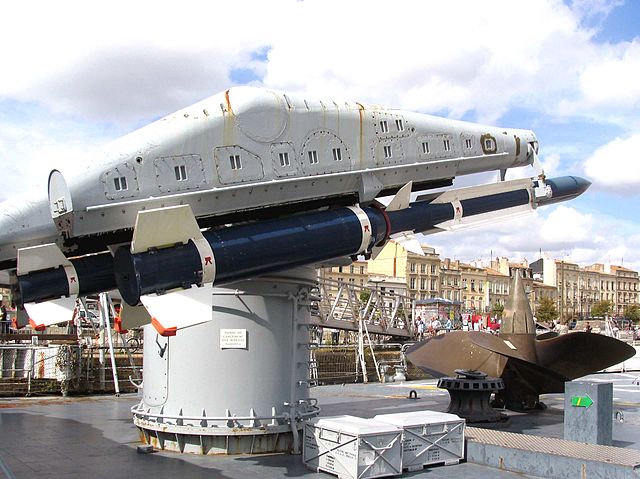
First tests started on the Île du Levant in 1958-59, then from 1960 in Ile d’Oléron, in an experimentation center. 50 test were made until 1968, both for operational validation on the Suffren and improved marks (three). Meanwhile, US missile systems were also adopted for the conversion of the destroyer Dupetit-Thouars (T47) with the RIM-2 Terrier, while the RIM-24 Tartar systems was installed in four other destroyers.
Colbert was to be equipped with the Masurca Mark 1, designed from 1960 in its final form, but only accepted in service in 1966. The launcher was placed aft, on the lower poop deck, just in front of the helipad, which needed to be cleaned up in case of a launch, as there was no hangar. The helicopter could be deployed to spot the missile launch anyway. The reload system was placed aft of the launcher, with a conveyor system for the stored missiles underneath the aft superstructure, 48 in all. From 1973, the system was upgraded to the Mark 2.
The MASURCA SAM was a two-stage weapon, with a rocket booster to reach operational altitude, and the missile proper. The latter was capable of Mach 3, weighted 950 kg (2,090 lb) plus its 1,148 kg (2,531 lb) booster, was 5.38 m (17 ft 8 in) plus 3.32 m (10 ft 11 in) with the booster for a diameter of 0.406 m (1 ft 4.0 in) and 0.770 m (2 ft 6.3 in) wingspan. It carried a 100 kg (220 lb) HE blast-fragmentation warhead with proximity fuze. Performances-wise, the Masurca reached 20,000–30,000 m (66,000–98,000 ft). It used an inertial initial guidance system and Semi-active radar homing for terminal approach.
The Masurca was guided by two DRBR 51B dish-style radars to track both missiles independently, placed just aft of the missile launcher on superfiring platforms. The whole electronics suite was modernized as well, notably the air warning radar.
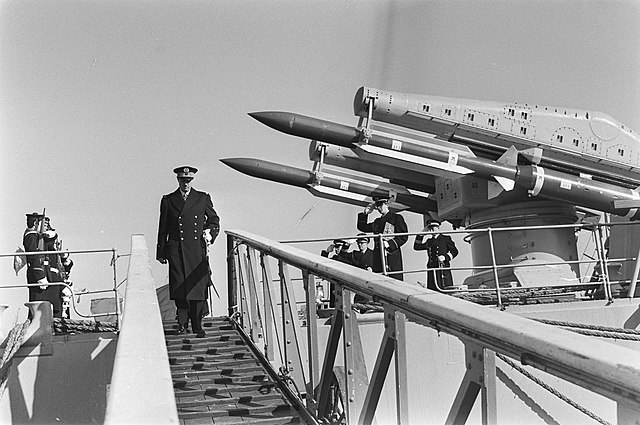
The refit
The aft part of the ship was completely rebuilt for the Masurca, the storage and reload system and the guiding radars above, but the main surveillance radar suite was also modified and new latice masts built: The bridge superstructure upper open bridge was rebuilt as an enclosed two-storey structure, with a small open bridge on top, a new lattice with two platforms, supporting a DECCA 1226 navigation system, a DRBV 50 radar above and a DRBV 23C radar on the upper platform. On both sides of the bridge were later installed a SATNAV, Syracuse system. At the aft end of the rebuilt bridge was constructed a new, sturdied lattice mast, supporting a DRBV 31 system, the main DRBV 23 surveillance radar, and navigational and communication systems.
Another big change was the aft mast, a brand new lattice that did not existed originally, and there to carry a whole array of sensors: At the very top, a TACAN navigation radar, and the same large DBRB 20C rectangular aerial that already existed on the 1959 configuration, but move from the funnel to the aft superstructure.
Armament wise, the elimination of the main 5-in guns was obvious, leaving some free space forward, which was occupied by two 100 mm Model 1968 dual purpose fast firing automated turrets now standard on the French Navy. They were placed on the pots occupied previously by the forwer axial 5-in turrets. The 57 mm AA turrets were also removed in part, but stil six were kept, two abaft the bridge and two amidship, abaft the funnel, as well as their guiding radars. Their role was to bring additional support firepower and constitute a last ditch, close quarter AA defense, complementary to the missile. But they were not comparable to modern autocannons.
When completed in 1972, Colbert had the following: Six twin 57mm/60, a twin Masurca Mk 2 Mod 2 SAM (48 in reserve), two 100mm/55 Mod 1968, assisted by DRBV-22A, two DRBC-31B, four DRBC-31A radars, a DRBV-23C, DRBV-50, two DRBI-51, two DRBC-32C radars, an ARBR-10F and ARBB-31/32 ECM suite, and two Corvus decoy Rocket Launchers. Complement was reduced to 560 thanks to automation and deletion of the old 5-in guns.
In 1974, the Masurca missile system was swapped for the Mk 2 Mod 3 SAM. In 1980, Colbert was fitted with four single MM38 Exocet SSM (4 MM38) canisters placed on the wings of the forward superstructure deck, providing antiship capailities. At that time was also installed the Syracuse Satnav/Satcom system and the decoy launchers were replaced by two Syllex chaff mortars on both sides of the bridge. She was also given two single cal.50 heavy machine guns, to deal with small boats and training.

⚙ Colbert’s 1972 Specs |
|
| Displacement | 12,500 tons FL |
| Armament | Four Exocet MM 38 (1980), 1×2 Masurca SAM, 2x 100mm, DP 6×3 57 mm AA, helipad. |
| Sensors | DRBV-22A, DRBI-10, 4x DRBC-31B, 4x DRBC-31A radars, DSBV-1 sonar, SENIT-1 CCS |
| Crew | 880 |
Colbert’s late career (1970-1991)
First based in Brest until 1976 for NATO atlantic exercises and as flagship of the Atlantic squadron. At the end of 1976, she took part in the celebrations for the bicentenary of the independence of the United States, representing France during the naval parade, and symboizing the decisive help of the French Navy back then. With the plan for redeployment of naval forces, dictated by the crisis in the Mediterranean theater, the Colbert left for Toulon. There, she reclaimed her role as flagship of the Mediterranean squadron. In 1980, she was equipped with four MM 38 Exocet missiles and in 1982, she was the first French Navy vessel to be fitted with the Syracuse satellite transmission system, two radomes, 2.50 meters in diameter, placed on boath sides, aft of the bridge.
After a period of various exercises cuises she took over another long range cruiser from August 6, 1988. She set sail for a four-month mission to Australia, to represent France at the bicentenary celebrations of this country. On May 16, 1990, she departed again for a new mission of representation, whose goal was the resumption of relations with the Soviet Navy. For the first time for any French ship, she anchored in Sevastopol, staying here from May 22 to May 26. The Colbert was nearing the end of her career, never firing a single shot in combat. Her last and only war mission was during the First Gulf War in 1991, just a few months before her disarmament: She participated in Operation Salamander. – In August 13, 1990 she headed to the Suez Canal for to escort the aircraft carrier Clemenceau, carrying men and materials to constitute the embryo of the “Daguet” division, involved in the ground Operation of Desert shield. Her last stopover took place in Venice, from April 12 to 19, 1991. On May 24, 1991, she was withdrawn from active service. Indeed the admiralty planned initially to retain her in active service until 1997, but due to post cold war budget cuts, this was advanced to 1993, and eventually two more years in advance, in May 24, 1991. She had fortunately a second life as museum ship, but this would not last long.

As a museum ship
The Colbert, being the last French cruiser, was soon presented to be a floating museum. An association was created for the purpose, which obtained public subsidies, both from the host city of Bordeaux, and the ministry of defence. After months of maintenance and preparation she was open to the public at quai des Chartrons, moored in the port of Bordeaux in June 1993. She became the most visited museum ship in France in 2004, and even the most visited “monument” in the city. Colbert was a private museum, and if the ship belonged to the State, she was managed by the association “Les Amis du Colbert”. A restaurant, fed by the one onboard the ship was stationed on the quay and many events were organized onboard, including seminaries. She became a landmark in the city, a recoignised tourist attraction as popular as HMS Belfast in London.
But despite of this in the 2000s, the museum ship aroused criticism from a part of the population. In part from ecologist associations and from a residents association named “Coulons le Colbert” (‘sink the colbert’) which had a candidate named during municipal elections in 1995. In addition, the museum association soon went into financial troubles. The State decided to cease subsidies in a context of severe budget restrictions, and the huge maintenance cost of the ship could no longer be covered. For example, the complete planned repainting of the ship, budgeted to 500,000 euros was way too steep for the museum’s touristic revenues and contributions. Yet, maintenance was necessary both for safety and the image of the city at large, which, especially in this part of the city, quite classy. Both under fire local environmental associations and the city itself, the Colbert was closed to the public on October 2, 2006. On May 31, 2007, the expiry date of the concession, she was towed out of the Gironde estuary into the Atlantic, and there to Brest.
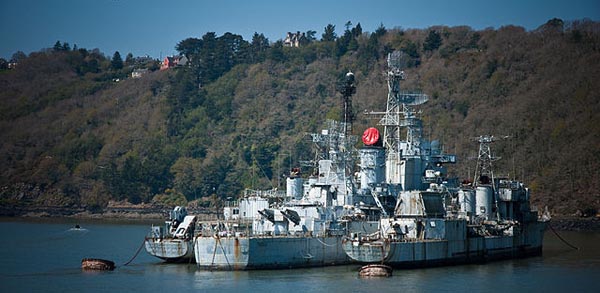
Colbert in landévénnec
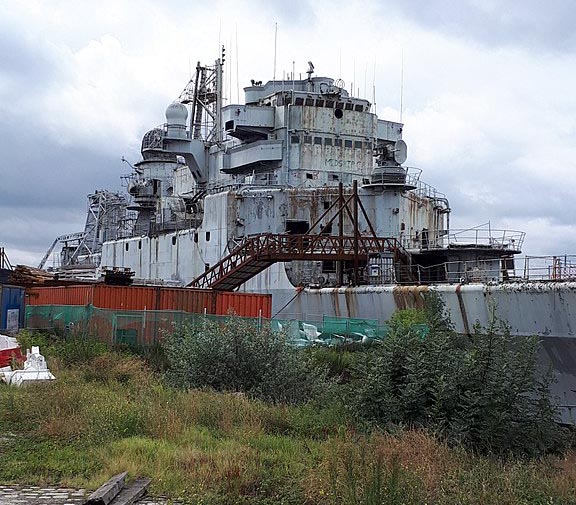
Colbert BU in Bassens, Gironde, 2017
Moored in the Landévennec ship cemetery, she waiting for her fate, cannibalized for spare parts for the Jeanne d’Arc, still in service, until herself was decommissioned in 2010. Colbert stayed there until June 12, 2014, when the navy announced she would leave for the return to the Gironde estuary, to be dismantled in Bassens, by the companies Bartin Recycling and Petrofer along with the Jeanne d’Arc. She only left Brest on June 3, 2016 for Bassens and was broken up until 2018. A fate similar to most prestige ships of the French Navy, like the battleships Richelieu or Jean Bart and the other cruisers. The French just don’t know and appreciate their navy, only seeing a waste of taxpayer’s money.
About the name: Colbert is named after Jean-Baptiste Colbert, a Louis XIV (The “sun king”) minister of marine, also considered the creator of the Marine Nationale, that he contributed to standardize and organize from 1661 to 1683. Many other ships were named after him, a 1848 paddle corvette, a 1877 ironclad frigate, a 1930, 10,000 tonnes Suffren class cruiser. She was not replaced (yet) but a future Frigate planed FY 2030 might took her name again.

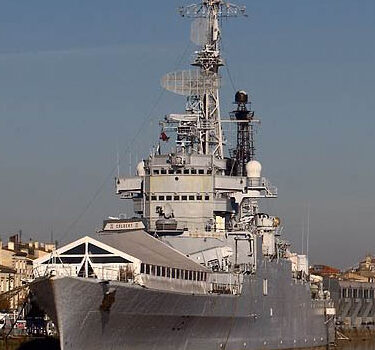

 Latest Facebook Entry -
Latest Facebook Entry -  X(Tweeter) Naval Encyclopedia's deck archive
X(Tweeter) Naval Encyclopedia's deck archive Instagram (@navalencyc)
Instagram (@navalencyc)





 French Navy
French Navy Royal Navy
Royal Navy Russian Navy
Russian Navy Armada Espanola
Armada Espanola Austrian Navy
Austrian Navy K.u.K. Kriegsmarine
K.u.K. Kriegsmarine Dansk Marine
Dansk Marine Nautiko Hellenon
Nautiko Hellenon Koninklije Marine 1870
Koninklije Marine 1870 Marinha do Brasil
Marinha do Brasil Osmanlı Donanması
Osmanlı Donanması Marina Do Peru
Marina Do Peru Marinha do Portugal
Marinha do Portugal Regia Marina 1870
Regia Marina 1870 Nihhon Kaigun 1870
Nihhon Kaigun 1870 Preußische Marine 1870
Preußische Marine 1870 Russkiy Flot 1870
Russkiy Flot 1870 Svenska marinen
Svenska marinen Søværnet
Søværnet Union Navy
Union Navy Confederate Navy
Confederate Navy Armada de Argentina
Armada de Argentina Imperial Chinese Navy
Imperial Chinese Navy Marinha do Portugal
Marinha do Portugal Mexico
Mexico Kaiserliche Marine
Kaiserliche Marine 1898 US Navy
1898 US Navy Sovietskiy Flot
Sovietskiy Flot Royal Canadian Navy
Royal Canadian Navy Royal Australian Navy
Royal Australian Navy RNZN Fleet
RNZN Fleet Chinese Navy 1937
Chinese Navy 1937 Kriegsmarine
Kriegsmarine Chilean Navy
Chilean Navy Danish Navy
Danish Navy Finnish Navy
Finnish Navy Hellenic Navy
Hellenic Navy Polish Navy
Polish Navy Romanian Navy
Romanian Navy Turkish Navy
Turkish Navy Royal Yugoslav Navy
Royal Yugoslav Navy Royal Thai Navy
Royal Thai Navy Minor Navies
Minor Navies Albania
Albania Austria
Austria Belgium
Belgium Columbia
Columbia Costa Rica
Costa Rica Cuba
Cuba Czechoslovakia
Czechoslovakia Dominican Republic
Dominican Republic Haiti
Haiti Hungary
Hungary Honduras
Honduras Estonia
Estonia Iceland
Iceland Eire
Eire Equador
Equador Iran
Iran Iraq
Iraq Latvia
Latvia Liberia
Liberia Lithuania
Lithuania Mandchukuo
Mandchukuo Morocco
Morocco Nicaragua
Nicaragua Persia
Persia San Salvador
San Salvador Sarawak
Sarawak Uruguay
Uruguay Venezuela
Venezuela Zanzibar
Zanzibar Warsaw Pact Navies
Warsaw Pact Navies Bulgaria
Bulgaria Hungary
Hungary

 Bundesmarine
Bundesmarine Dutch Navy
Dutch Navy Hellenic Navy
Hellenic Navy Marina Militare
Marina Militare Yugoslav Navy
Yugoslav Navy Chinese Navy
Chinese Navy Indian Navy
Indian Navy Indonesian Navy
Indonesian Navy JMSDF
JMSDF North Korean Navy
North Korean Navy Pakistani Navy
Pakistani Navy Philippines Navy
Philippines Navy ROKN
ROKN Rep. of Singapore Navy
Rep. of Singapore Navy Taiwanese Navy
Taiwanese Navy IDF Navy
IDF Navy Saudi Navy
Saudi Navy Royal New Zealand Navy
Royal New Zealand Navy Egyptian Navy
Egyptian Navy South African Navy
South African Navy






























 Ukrainian Navy
Ukrainian Navy dbodesign
dbodesign